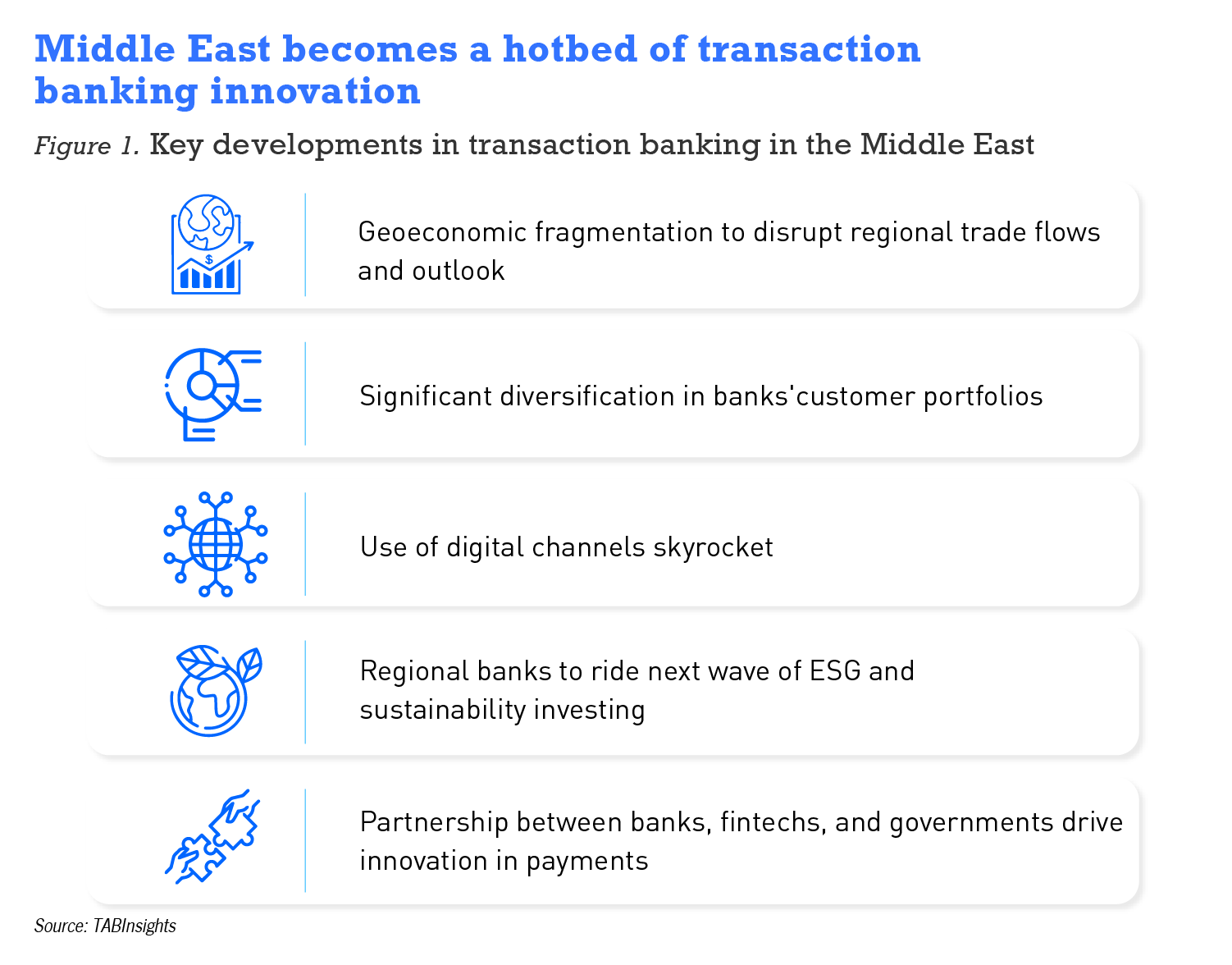- Poised for significant growth amid complex operating environment
- Collaborations between banks, fintechs, and government entities in GCC
- Adoption of APIs in cash management a key development area in 2024
Banks in the Middle East are negotiating a challenging environment as increased costs of servicing trade finance combined with geopolitical instability threaten to disrupt trade and supply chain flows. Despite this outlook, prospects in the region are nevertheless promising thanks to innovation in the financial services industry.
Drivers of change in Middle East transaction banking
As economies in the Gulf Cooperation Council (GCC) lessen dependence on revenues from oil exports, transaction banks in the region are warming up to non-oil sectors with high potential for growth. Key Middle East banks interviewed in the TABInsights survey demonstrated a 13% contraction in oil and gas financing and a 100% increase in funding for the technology sector.

Banks in GCC economies have also been rapidly growing customer bases outside domestic regions. For instance, major Middle East banks with strong balance sheets are focusing on Asian markets in an effort to capture dynamic trade flows and gain access to new opportunities. Some of the largest banks have set up small operations in Asian financial hubs such as Singapore and Hong Kong.
In the payments and collections sphere, there has been a shift to digital channels, with utilisation rising to over 90% from the previous 70% year-on-year. This reflects how quickly banks and their customers have embraced technology. However, the adoption of digital trade finance solutions remains uneven, highlighting the disparity in the industry’s technological progress.
Banks in the Middle East are taking a step towards sustainability by offering trade finance facilities linked to environmental benchmarks. This is in line with the global shift towards cleaner energy and engineering initiatives. This trend is reflected by the prioritisation of education and infrastructure developments in the African subcontinent, suggesting a broader realignment of sectoral funding priorities.
Banks here are also expediting customers’ carbon neutrality journeys with sustainability-linked supply chain finance solutions. In partnership with benchmarking firms working in environmental, social and governance (ESG) initiatives, banks offer tiered discount pricing based on supplier ESG ratings and fulfillment of key performance indicators.
To improve financial inclusion, banks, fintechs, and government organisations are collaborating strategically especially when it comes to international payments. Fintech and platform collaboration is projected to significantly increase to 55% by 2024, according to the heatmap in Figure 2. This trend suggests a growing emphasis on cooperation between financial technology firms and platforms.
There has been substantial cooperation between central banks and international organisations such as the Arab Monetary Fund. The joint efforts in Project BUNA, for instance, are focused on laying the groundwork for regional payment systems in the Middle East and North Africa. The goal of these systems is to improve the integration of economies within the Arab region.
Another example is the establishment of the Afaq system. Many banks are engaging with central banks and policy makers to get the Afaq Payment System rolling; this was formerly the GCC real-time gross settlement (RTGS). Afaq will link the individual systems of the six GCC countries, enabling efficient intra-GCC payments in each country’s currency. The Afaq system eliminates the need for correspondent banking because payments in Saudi Riyals from the United Arab Emirates to Saudi Arabia will be processed through the domestic systems of both nations. Afaq is currently live in Saudi Arabia, Kuwait, and Bahrain, with more countries expected to join in the future.

TABInsights conducted a heatmap analysis of key cash management and trade finance focus areas based on survey data from major corporate and transaction banks in Asia Pacific and Middle East. The analysis depicts the evolution of focus areas by aggregating the data for best practices as ranked by the percentage of respondents who consider them important each year.
As the pandemic restricted mobility, demand for mobile payments surged leading up to 2022, with more institutions enhancing technological capabilities to meet this demand. Transactions in the Middle East grew significantly because of large volumes of outgoing remittances-based mobile solutions. Cash management application programming interfaces (APIs) and virtual account solutions also had wider uptake on account of tighter liquidity and real-time needs of corporate treasury on transaction statuses and account balances. Comprehensive API-based propositions covering cash, cheque deposits and cash withdrawals became popular in the region.
It is expected that towards the end of 2024, the adoption of the IS0 20022 payments messaging standards will further accelerate the expansion of cross-border payment solutions. Given the plethora of domestic and cross-border payment schemes such as Afaq and BUNA, banks here must manage multiple ISO 20022 modernisation programmes.
The adoption of ESG and sustainability as best practices will also strengthen in 2024. It is expected that its significance will grow from 3% in 2020 to an estimated 30% in 2024. Through partnerships with ESG rating firms and vendors, banks will be closer to meeting their sustainability targets and helping customers in key markets meet sustainability objectives.

































